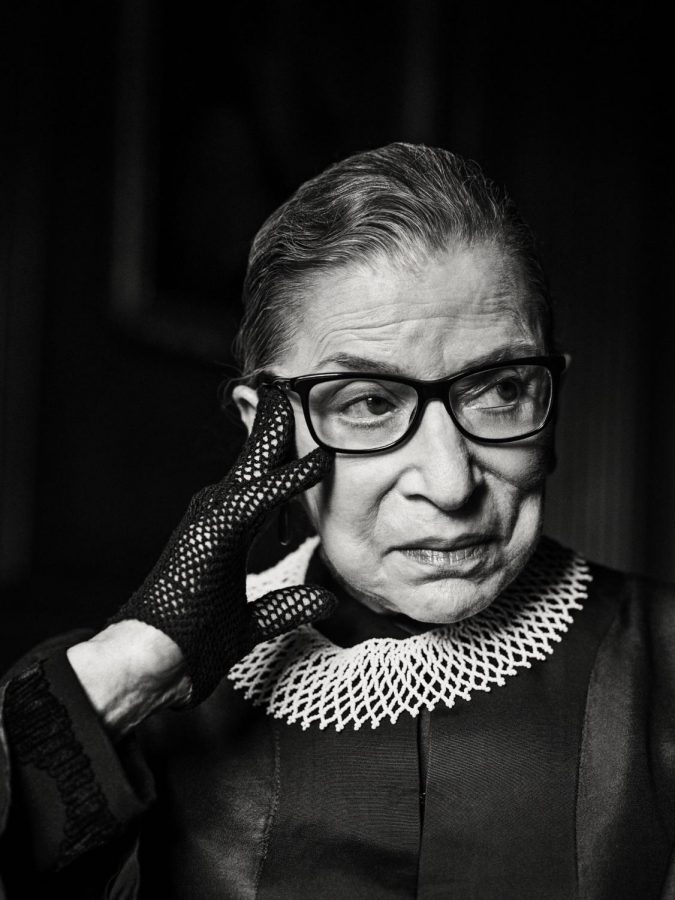Remembering Ruth Bader Ginsberg
Ginsberg served on the Supreme Court from 1993 until her death in 2020.
November 4, 2020
The recent passing of Supreme Court Justice Ruth Bader Ginsburg has created both sorrow and political unrest in our nation. After 27 years on the Supreme Court, Ginsburg passed away on Sept. 18 at the age of 87. She opened many doors for women in her career. She was seen as the definition of a ‘feminist.’ According to Global Citizen, Ginsburg championed laws that ensured the following: employers could not legally discriminate against employees on the basis of gender or reproductive rights, schools funded by the state were required to admit women, women had rights to be independent financially and to have equal benefits, men were entitled to the same rights to Social Security and caregiving as women, and juries must contain women. These are only five issues out of many that Ginsburg invested her time and energy into supporting in order to promote equality. Ginsburg was the second woman to sit on the Supreme Court in the 212 years of its establishment, after Sandra Day O’Connor, and she made sure to make use of it.
Ginsburg earned an astounding law resume by graduating from Cornell University and going on to attend both Harvard Law School and Columbia Law School, where she was at the top of her classes, the National Women’s Hall of Fame stated. She also made Law Review at both schools. Despite her successes, she still struggled against the patriarchy, and it was very difficult for her to find a post-graduate job. She served a clerkship at the United States District Court of Appeals in New York and later went on to become the first female law professor at Columbia Law School. She also taught at Rutgers University School of Law. Ginsburg was later appointed to the United States Court of Appeals for the District of Columbia in 1980 under the administration of President Jimmy Carter. In 1993, she was appointed to the United States Supreme Court, where she served until her passing.
“Women’s rights are an essential part of the overall human rights agenda, trained on the equal dignity and ability to live in freedom all people should enjoy.” This quote by Ginsburg displays the work she aimed to achieve. One of Ginsburg’s first defining cases she worked on was Moritz vs. Commissioner of Internal Revenue in 1970, a case that entailed a man named Charles Moritz, who was not able to pay a nurse that cared for his mother because he was her son, not her daughter. This law implied that women were to fill the role of caretakers. This case was the first of Ginsburg’s cases that sought out to break gender stereotypes that were so deeply implemented in society and culture. This case inspired Ginsburg to be the trailblazer for women’s rights activism within the Supreme Court. Not only had she seen unfair laws, but she also experienced inequality first-hand in her male-dominated profession.
In addition to being a beacon of feminism, Ginsburg stood up for the rights of other marginalized groups, such as the LGBTQ community and other minorities. Ginsburg not only looked to broaden access to reproductive healthcare and prenatal care, but she also aided in legalizing gay marriage in all 50 states. She granted state-funded support to the disabled within their communities, as the disabled are commonly overlooked within the passing of laws. According to The New York Times, one of her proudest achievements was the Lilly Ledbetter Fair Pay Act of 2009; she even put a framed copy on the wall of her chambers. This act prohibits discrimination in pay to those in the workplace. This law is one example of the passion Ginsburg had for using her positions as both a lawyer and judge to protect equal rights.
Ginsburg was a force to be reckoned with in the Supreme Court, as one of the few women appointed and being exceptionally liberal compared to her colleagues. Ginsburg was pro-women, pro-immigration, and pro-minority, which was intimidating to her majority conservative counterparts. As stated by The New York Times, Ginsburg was the leader of the liberal wing of the Supreme Court in the recent time before her death. They also stated, “By the time Justice Ginsburg joined the court, her legacy was secure. She was the leading women’s rights litigator in the nation’s history and a counterpart to Justice Thurgood Marshall, who had led the effort to secure racial equality in the courts.”
With the passing of such a prominent figure on the Supreme Court, comes a myriad of controversy about who is the most qualified to fill her seat. President Donald Trump selected Amy Coney Barrett as his nominee, a controversial choice because Barrett’s values contrast sharply with the legacy that Ginsburg built. Ginsburg was anti-authoritarian and sought to promote equality in her time on the court and according to NPR, she stated to her granddaughter Clara Spera: “My most fervent wish is that I will not be replaced until a new president is installed.” It has become clear that Ginsburg’s dying wish will likely not be honored as Trump is currently in a rush to fill her seat before the time of the Presidential Election. This is the shortest time frame that a seat on the Supreme Court is being filled. The last time that a death occurred before an election in 2016, Senate Majority Leader Mitch McConnell would not allow the consideration of a nominee nine months before the election. Now it is clear that in this situation, he is not taking the same route.
The passing of Justice Ruth Bader Ginsburg will continue to be mourned by our country. Ginsburg has accomplished so much in terms of equality and the rights of Americans who are not always spoken for. She will forever have a mark on the history of feminism and equality.
